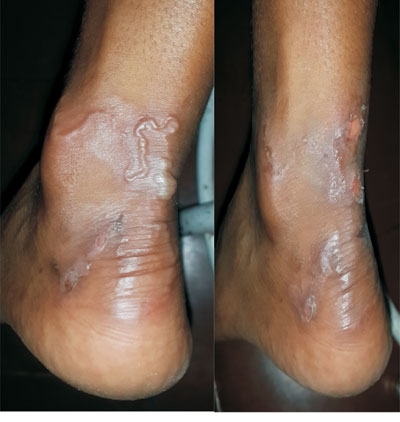An 8-year-old boy from Agatti Island in Lakshadweep, India presented
with history of intensely pruritic skin lesions on the posterior aspect
of the leg for last 2 days. There were no systemic symptoms. Clinical
examination revealed an erythematous, serpentine lesion at the posterior
aspect of leg with vesicles at the edge of the lesion (Fig. 1a).
The boy used to play football on the beach barefoot everyday. He had
similar lesions on the same leg a few months earlier, which were treated
with topical antifungal cream. A diagnosis of cutaneous larva migrans
was made and he was started on oral albendazole at 400 mg once daily for
5 days. Lesions healed rapidly leaving patchy excoriation of the skin
secondary to scratching (Fig. 1b).
 |
|
Fig. 1 (a) Raised and serpentine
lesions of cutaneous larva migrans, (b) Post-treatment picture
showing healing and excoriations secondary to scratching.
|
Cutaneous larva migrans is diagnosed by classical
serpentine skin lesions in a tropical setting. The differential
diagnoses include scabies (generalized, burrows in inter-digital spaces)
cutaneous bacterial and fungal infections, and contact dermatitis.

